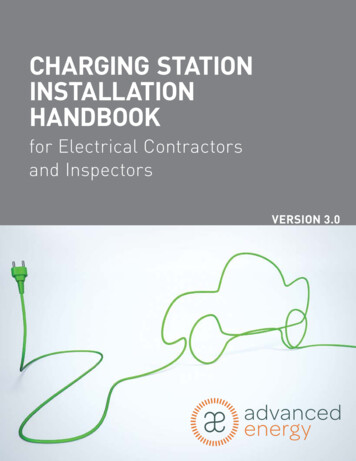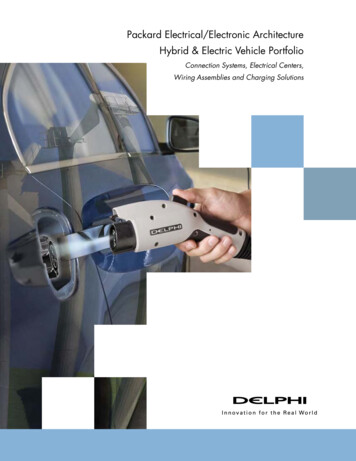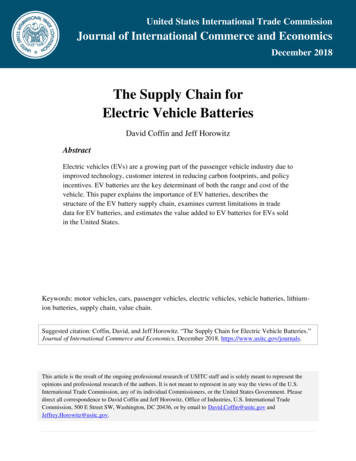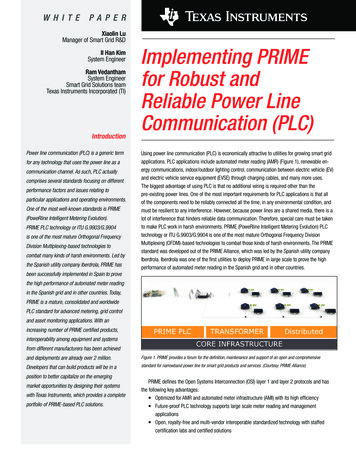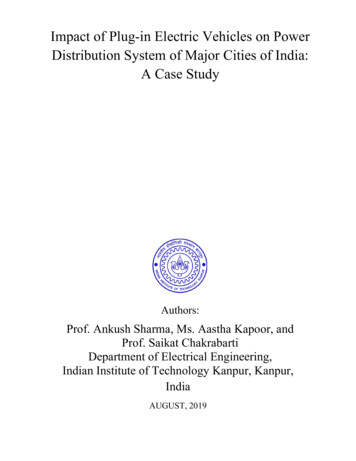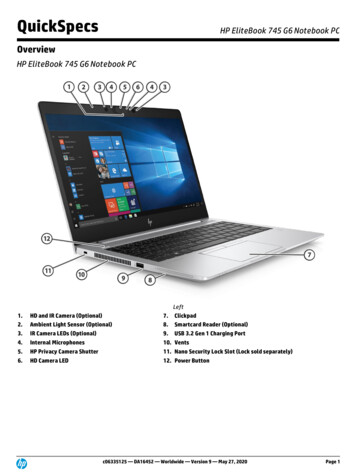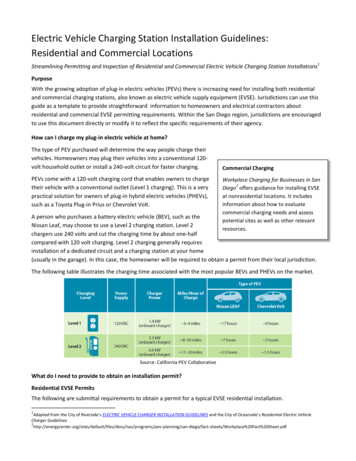
Transcription
Electric Vehicle Charging Station Installation Guidelines:Residential and Commercial LocationsStreamlining Permitting and Inspection of Residential and Commercial Electric Vehicle Charging Station Installations1PurposeWith the growing adoption of plug-in electric vehicles (PEVs) there is increasing need for installing both residentialand commercial charging stations, also known as electric vehicle supply equipment (EVSE). Jurisdictions can use thisguide as a template to provide straightforward information to homeowners and electrical contractors aboutresidential and commercial EVSE permitting requirements. Within the San Diego region, jurisdictions are encouragedto use this document directly or modify it to reflect the specific requirements of their agency.How can I charge my plug-in electric vehicle at home?The type of PEV purchased will determine the way people charge theirvehicles. Homeowners may plug their vehicles into a conventional 120volt household outlet or install a 240-volt circuit for faster charging.PEVs come with a 120-volt charging cord that enables owners to chargetheir vehicle with a conventional outlet (Level 1 charging). This is a verypractical solution for owners of plug-in hybrid electric vehicles (PHEVs),such as a Toyota Plug-in Prius or Chevrolet Volt.Commercial ChargingWorkplace Charging for Businesses in San2Diego offers guidance for installing EVSEat nonresidential locations. It includesinformation about how to evaluatecommercial charging needs and assesspotential sites as well as other relevantresources.A person who purchases a battery electric vehicle (BEV), such as theNissan Leaf, may choose to use a Level 2 charging station. Level 2chargers use 240 volts and cut the charging time by about one-halfcompared with 120 volt charging. Level 2 charging generally requiresinstallation of a dedicated circuit and a charging station at your home(usually in the garage). In this case, the homeowner will be required to obtain a permit from their local jurisdiction.The following table illustrates the charging time associated with the most popular BEVs and PHEVs on the market.Source: California PEV CollaborativeWhat do I need to provide to obtain an installation permit?Residential EVSE PermitsThe following are submittal requirements to obtain a permit for a typical EVSE residential installation.1Adapted from the City of Riverside’s ELECTRIC VEHICLE CHARGER INSTALLATION GUIDELINES and the City of Oceanside’s Residential Electric VehicleCharger -sheets/Workplace%20Fact%20Sheet.pdf
Supporting DocumentationPlot PlanElectrical Load CalculationsElectrical PlansEVSE InformationDescriptionIdentify the complete layout of existing parking spaces and proposed location ofEVSE parking space(s) with respect to existing building and structuresHome electrical load calculation that estimates if an existing electrical service willhandle the extra load from residential EVSE and wiring methods based on theCalifornia Electrical Code (see sample electrical plan)Single-line diagrams showing the system, point of connection to the powersupply and the EVSEThe EVSE manufacturer’s installation instructions and charger specifications(Note: Jurisdictions may need to modify this list to reflect their specific requirements)In most cases, homeowners or contractors simply need to submit the documentation outlined above to the localpermitting office (usually the building and safety division) for review and permit issuance. PEV owners andcontractors are encouraged to check their local jurisdiction’s permitting website to see if this process is availableonline. If not, they will likely need to visit the permitting office for an over-the-counter review and permit issuance.If all of the information is provided and the proposal complies with the applicable codes, the review and approvalprocess occurs shortly thereafter. It is important to note that load calculations per California Electrical Code (CEC),Article 220, are required if the existing service panel is rated less than 200 amps. Electrical panel upgrades andelectrical wiring must be in conformance with the current edition of the CEC.Commercial EVSE PermitsInstallation of EVSE at commercial locations can be more complex than residential installations and may requireadditional permits or submittal documentation. The following are considerations for commercial EVSE. Zoning Requirements Community or Design Guidelines Existing Use Permits Electrical Source/Metering Parking and Signage Requirements Permit and Inspection FeesA simple commercial EVSE installation may have similar permitting requirements as a residential installation withthe addition of a tenant improvement electrical permit. A more complex commercial installation may require amodification to an existing use permit or site plan addressing specific community or zoning design criteria. It isimportant to meet with staff at the jurisdiction’s building department and, if necessary, planning department, tounderstand fully all of the requirements and fees prior to submitting permits.Do I need to get my charging station inspected by the permitting jurisdiction?All jurisdictions in the San Diego region require an inspection of an installed EVSE. When the installation iscomplete, an inspection of the work is scheduled with the building inspector upon request. Generally, inspectionsoccur less than one week after the request. Typically, the homeowner or property owner (or tenant) needs to bepresent during the inspection so that the inspector can access the charging station location and review any otherelectrical or structural change. See the attached EVSE Inspection Checklist, which is designed to serve as a guidefor local building inspectors and is endorsed by the National Electrical Contractors Association. A residentialchecklist used in the cities of Oceanside and San Diego is also included.How do I install a charging station?Residential InstallationsInstalling residential EVSE may require changes to the home’s electrical wiring and prompt selectingdifferent utility electricity rates.
For a step-by-step installation guideline, view the attached Plug-in and Get Ready document. Formore information on PEV charging stations currently available on the market, visitwww.GoElectricDrive.com.Commercial InstallationsCommercial EVSE installations are often specific to the location and the proposed use. It is advisable toconsult the permitting and/or planning agency before breaking ground.When installing a home or commercial charging station, property owners are encouraged to choose a localelectrical contractor with the proper expertise, information, tools and training for installing EVSE to ensure ahigh-quality and efficient installation experience. Please reference the wiring methods based on theCalifornia Electrical Code attached.Why would SDG&E need to know about your charging station?San Diego Gas & Electric (SDG&E) needs to accurately track the number of PEV charging stations installed toproperly plan for local increases in electricity demand due to vehicle charging. The combined effect ofseveral chargers in the same area could result in overloads on utility secondary wires and transformers.Therefore, utility notification is an important component of providing safe, reliable electricity to all SDG&Ecustomers.SDG&E can help businesses understand pricing options and identify potential EVSE rebates and incentives.Load Level of Residential ChargingSDG&E’s Clean Transportation Program created the figure below that displays the significant load differenceof a residential EVSE as compared with typical household appliances. According to SDG&E, a PEV charging at9.6 kW may double or triple a household’s prior peak load. In addition, PEV owners who notify SDG&E of aresidential EVSE installation will learn about their PEV time-of-use (EV TOU) rates that provide a significantlylower electricity cost of for PEV owners who charge at night, when demand is lower.Source: San Diego Gas & Electric
LEVEL 2 ELECTRIC VEHICLE CHARGER - SERVICE LOAD CALCULATIONINSTRUCTIONS: Review the list of electrical loads in the table below and check all that exist inthe home (don’t forget to include the proposed Level 2 EV Charger). For each item checked,fill-in the corresponding “Watts used” (refer to the “Typical Usage” column for wattageinformation). Add up all of the numbers that are written in the “Watts Used” column. Write thatnumber in the “Total Watts Used” box at the bottom of the table and proceed to the next page.(Loads shown are rough estimates; actual loads may vary – for a more precise analysis, use the nameplateratings for appliances and other loads and consult with a trained electrical professional.)9Check AllApplicableDescription of LoadTypical usageWatts usedLoadsGENERAL LIGHTING AND RECEPTACLE OUTLET CIRCUITS9Multiply the3 watts/sq. ft.Square Footage of House X 3KITCHEN CIRCUITS9Kitchen Circuits3,000 watts3,000Electric oven2,000 wattsElectric stove top5,000 wattsMicrowave1,500 wattsGarbage Disposal under kitchen 1,000 wattssinkAutomatic Dish washer3,500 wattsGarbage Compactor1,000 wattsInstantaneous hot water at sink1500 wattsLAUNDRY CIRCUIT9Laundry Circuit1,500 watts1,500Electric Clothes Dryer4,500 wattsHEATING AND AIR CONDITIONING CIRCUITSCentral Heating (gas) and Air6,000 wattsConditioningWindow mounted AC1,000 wattsWhole-house or attic fan500 wattsCentral Electric Furnace8,000 wattsEvaporative Cooler500 wattsOTHER ELECTRICAL LOADSElectric Water Heater (Storage4,000 wattstype)Electric Tankless Water Heater15,000 wattsSwimming Pool or Spa3,500 wattsOther: (describe)Other:Other:ELECTRIC VEHICLE CHARGER CIRCUITLevel 2 Electric Vehicle Charger rating*(Add-up all of the watts for the loads you have checked 9)TOTAL WATTS USED Î*Use name plate rating in watts or calculate as: (Ampere rating of circuit X 240 volts Watts)G:\BLDG\ORIGINALS\EV Charger Guidelines 4-15-2011
INSTRUCTIONS: Apply the Total Watts Used number from the previous page to theTable below to identify if the Existing Electrical Service Panel is large enough to handle theadded electrical load from the proposed Level 2 EV Charger. If your electrical service isNOT large enough, then you will need to install a new upgraded electrical service panel.Table based on NEC 220.83 (A).9ChecktheappropriatelineTotal Watts Usedup to 24,00024,001 to 48,00048,001 to 63,00063,001 to 78,00078,001 to 108,000108,001 to 123,000Minimum Required Size ofExisting 240 Volt ElectricalService Panel(Main Service Breaker Size)60 amp100 amps125 amps150 amps200 amps225 ampIdentify the Size ofYour Existing MainService Breaker(Amps)****Please note that the size of your Existing service MUST be equal to or larger than theMinimum Required Size identified in the Table above or a New Upgraded electrical servicepanel will need to be installed (separate permit required for new service).CAUTION: This table is NOT to be used to determine the size of a NEW UPGRADEDElectrical Service Panel if your existing panel is too small or overloaded according theTable above. In order to determine the size of a NEW or UPGRADED Service Panel, thereis a completely different load calculation methodology that applies. Sizing of a NEW orUPGRADED Electrical Service Panel should only be done by a qualified ElectricalContractor or Electrical Engineer.STATEMENT OF COMPLIANCEBy my signature, I attest that the information provided is true and accurate.Job Address:(Print job address)Signature:(Signature of applicant)(Date)In addition to this document, you will also need to provide a copy of themanufacturer’s installation literature and specifications for the Level 2 Charger youare installing.Please note that this is a voluntary compliance alternative and you may wish to hire a qualifiedindividual or company to perform a thorough evaluation of your electrical service capacity in lieu ofthis alternative methodology. Use of this electrical load calculation estimate methodology and formsis at the user’s risk and carries no implied guarantee of accuracy. Users of this methodology andthese forms are advised to seek professional assistance in determining the electrical capacity of aservice panel.G:\BLDG\ORIGINALS\EV Charger Guidelines 4-15-2011
OTHER HELPFUL INFORMATION FOR EV CHARGER INSTALLATIONS:The Table below illustrates the type and size of wire and conduit to be used for variousElectric Vehicle Charger circuits.Size ofEV ChargerCircuit BreakerRequiredminimum sizeof Conductors(THHN wire)20 amp30 amp40 amp50 amp60 amp70 amp#12#12#10#8#6#6Conduit Type and Size***RigidElectricalNonmetallicFlexible MetalMetallic TubingConduit –Conduit(EMT)Schedule ��3/4”3/4”3/4”***Based on 4 wires in the conduit (2-current carrying conductors, 1-groundedconductor, 1-equipment ground).As an alternate, Nonmetallic Sheathed Cable (aka: Romex Cable or NMC) may beused if it is protected from physical damage by placing the cable inside a wall cavityor attic space which is separated from the occupied space by drywall or plywood.The Table below illustrates the required supports for various types of electrical conduit umdistance frombox NonmetallicConduit –Schedule 40(RNC)Flexible �3’4-1/2’4-1/2’3’3’1’1’In addition to the above noted requirements, the California Electrical Code contains manyother provisions that may be applicable to the installation of a new electrical circuit.Installers are cautioned to be aware of all applicable requirements before beginning theinstallation. For additional information or guidance, consult with the Building and SafetyDivision staff or a qualified and experienced Electrical Contractor.G:\BLDG\ORIGINALS\EV Charger Guidelines 4-15-2011
Electric Vehicle Charging Station Installation Guidelines: . guide as a template to provide straightforward information to homeowners and electrical contractors about residential and commercial EVSE permitting requirements. . which is designed to serve as a guide for local building inspectors and is
